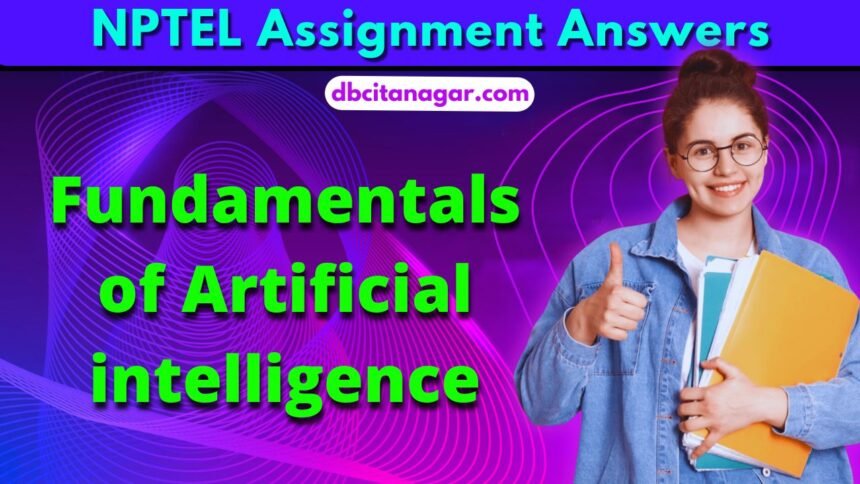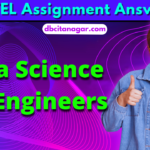NPTEL Fundamentals of Artificial intelligence Week 12 Assignment Answers 2024
1. Reinforcement Learning is general than supervised or unsupervised learning; an agent learns from interaction with the environment to achieve a goal. Learning is based on the ____________.
A. multi-layer perceptron.
B. support vector machines.
C. rewards hypothesis.
D. knowledge representation and reasoning.
Answer :- For Answers Click Here
2. A computational model of a single neuron that can only represent linearly separable functions is the __.
A. Perceptron.
B. Restricted Boltzmann Machine.
C. Autoencoder.
D. Convolutional Layer
Answer :- For Answers Click Here
3. A key difference between traditional Machine Learning (ML) and Deep Learning (DL) is in how features are extracted. Which of the following statements are true? I. Traditional ML approaches use handcrafted engineering features by applying several feature extraction algorithms, and then apply the learning algorithms II. In the case of DL, features are learned automatically and represented hierarchically in multiple levels.
A. Statements I and II
B. Only Statement II
C. Only Statement I
D. None.
Answer :- For Answers Click Here
4. ____________ offer an alternative approach to maximum likelihood estimation techniques; an unsupervised deep learning approach where two neural networks compete against each other in a zero-sum game.
A. Convolutional Neural Networks
B. Recurrent Neural Networks
C. Generative Adversarial Networks
D. Autoencoders
Answer :-
5. A Reinforcement Learning (RL) agent interacting in an environment may include one or more of these components: Policy, Value function and Model. Identify the correct statements in the context of a RL agent?
A. A policy is the agent’s behaviour and is a map from state to action.
B. A model is the agent’s representation of the environment; predicts what it will do next.
C. The environment need not be observable
D. Value function is a prediction of the next state.
Answer :-
6. In reinforcement learning, rather than finding a mapping from states to state values, ______ finds a mapping from state/action pairs to values.
A. Value Iteration
B. Q-learning
C. Reinforcement function
D. Value function
Answer :- For Answers Click Here
7. Assertion: In Deep Feed-forward Networks, multiple hidden layers help in modelling complex nonlinear relation more efficiently. Reason: Backpropagation using gradient descent is the most common learning algorithm used to train this model. Mark the correct choice as
A. Both A and R are true and R is the correct explanation for A
B. Both A and R are true but R is not the correct explanation for A
C. A is True but R is False
D. A is false but R is True
Answer :-
8. Assertion: In a Reinforcement Learning (RL) agent, a policy is the agent’s behaviour and is a map from state to action. Reason: A model is the RL agent’s representation of the environment and predicts what the agent will do next. Mark the correct choice as
A. Both A and R are true and R is the correct explanation for A
B. Both A and R are true but R is not the correct explanation for A
C. A is True but R is False
D. A is false but R is True
Answer :-
9. Assertion: The layers involved in any CNN model are the convolution layers and the subsampling / pooling layers which allow the network learn filters that are specific to specific parts in an image. Reason: The convolution layers help the network retain the spatial arrangement of pixels present in any image; the pooling layers summarize the pixel information. Mark the correct choice as
A. Both A and R are true and R is the correct explanation for A
B. Both A and R are true but R is not the correct explanation for A
C. A is True but R is False
D. A is false but R is True
Answer :-
10. Deep Learning (DL) which uses either deep architectures of learning or hierarchical learning approaches is a class of Machine Learning (ML). Identify the statements correct below.
A. DL approaches do not require precisely defined features.
B. Traditional ML approaches use handcrafted engineering features by applying several feature extraction algorithms, and then apply the learning algorithms.
C. In DL, the features are learned automatically and represented hierarchically in multiple levels.
D. The DL approach is not scalable.
Answer :- For Answers Click Here






